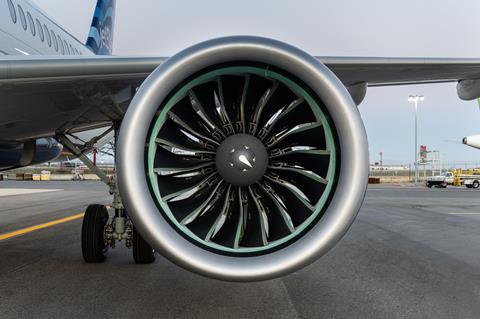US carrier JetBlue Airways lost $716 million in the first quarter as “significant elevated capacity” in Latin America and on domestic routes cut into the already-struggling airline’s performance.
That compares with a $192 million loss during the first quarter of 2023.
New York-based JetBlue also disclosed during its earnings call on 23 April that its revenue in the quarter dipped 5% year on year to $2.2 billion. It expects competition in some international markets will continue suppressing revenue throughout 2024.
“As we look to the full year, significant elevated capacity in our Latin region, which represents a large portion of JetBlue’s network, will likely continue to pressure revenue, and we expect a setback in our expectations for the full year,” says chief executive Joanna Geraghty.

The company now anticipates its full-year 2024 revenue will decrease year on year in the single-digit percentage range, and that its capacity, measured by available seat miles, will also decline significantly. The short-term outlook is especially rough, as the company expects its revenue will decline 6.5-10.5% year on year in the second quarter.
FIRST QUARTER BLUES
JetBlue has been struggling on multiple fronts in the aftermath of the collapse of its proposed $3.8 billion acquisition of Spirit Airlines, a deal blocked on antitrust grounds by a federal judge. The carrier’s Northeast Alliance with American Airlines met a similar fate last year.
Now seeking a way forward, JetBlue’s growth is constrained because many of its jets are grounded for lengthy engine inspections and repairs.
The carrier previously stated that it expects double-digit numbers of aircraft to be grounded at any given time this year due to Pratt & Whitney’s recall of more than 1,000 PW1000G-family engines. P&W is taking those engines off-wing to address a defective disc issue it identified last summer.
Cirium fleets data show that JetBlue currently has 10 jets in storage – seven Airbus A321neos (powered by PW1100Gs) and three A220-300s (powered by PW1500Gs). It could have as many as 13-15 jets grounded at the end of the year.
Last month, JetBlue signalled it was trimming unprofitable routes across it network, including flights to Bogota, Peru and Quito, and several domestic routes in an attempt to right the ship. “Some of the some of the network changes were directly related to aircraft shortfalls due to our situation with Pratt,” says president Marty St George.

But the carrier’s issues extend beyond the durability of next-generation jet engines. As the barrier between business and leisure travel has dissolved following the Covid-19 pandemic, Geraghty says, “more people can take advantage of the ability to work from anywhere”.
”However, that also means most of the industry has shifted a portion of their flying to meet this increasing demand for leisure travel, allocating capacity to many of JetBlue’s bread-and-butter routes,” she says.
Company executives say they have a long-term profitability plan but have yet to divulge details. Geraghty says JetBlue’s recently remade leadership team needs more time to “pressure test” the strategy before sharing it with investors.
“We also need to make additional progress with Pratt & Whitney to feel confident in our multi-year growth plans,” she says.
JetBlue has postponed its annual investor day, previously scheduled for 30 May, until sometime this fall.
‘STEADILY IMPROVING’
Aside from the Latin America region, JetBlue’s network is “steadily improving”, according to St George. ”We remain committed to winning our high-margin, core geographies and returning to profitability again, driven by our refocused strategy to better serve our core customers.”
The carrier is taking a number of short-term actions, including extending the life of its existing A320 fleet. Since the end of the third quarter of last year, JetBlue has purchased or committed to purchase a dozen older A320s that were due to return to lessors.
Moving forward, JetBlue could elect to extend the life of another 30 older aircraft – seven A320s and 23 E190s.
“As we continue to work through near-term growth challenges stemming from the engine issues, we are exploring cost-effective and capital-light ways to grow our fleet,” Hurley says.
As for new aircraft deliveries from Airbus, JetBlue expects to take 20 A220s through year-end, along with seven A321neos.
”Prioritising A220 deliveries in the near term helps to better match the needs of our customers with our cost goals, while continuing to evolve our product offering,” Hurley says.
The carrier hopes that adding more premium seats across its narrowbody fleet will boost profitability. It is replacing its ageing fleet of E190s with the incoming A220s, which will save the carrier an estimated $100 million in 2024 due to the greater efficiency of the A220.
JetBlue held $1.7 billion in cash and equivalents on 31 March, roughly even with the amount it held on the same date last year.
























